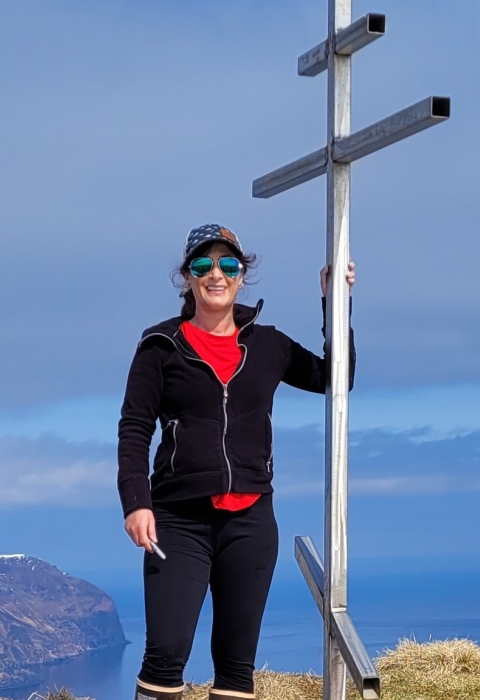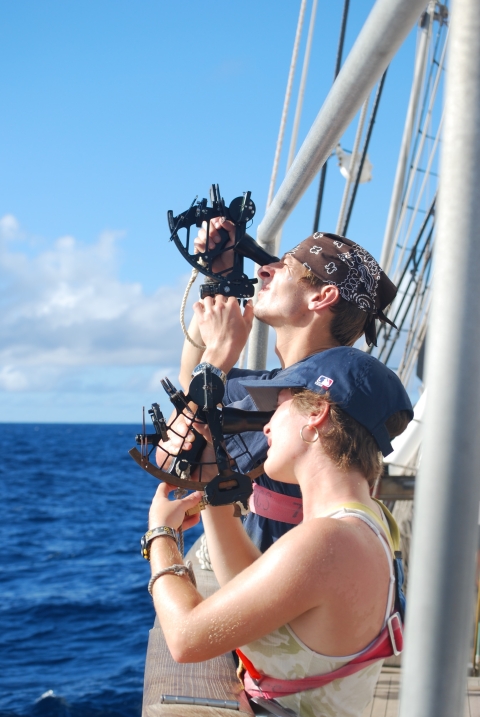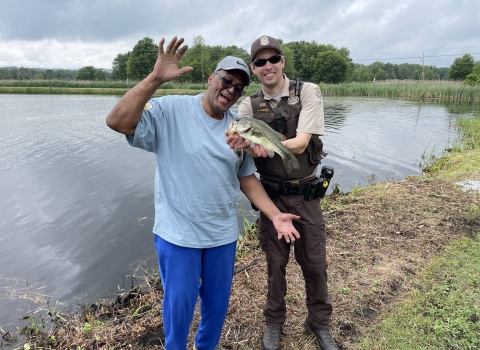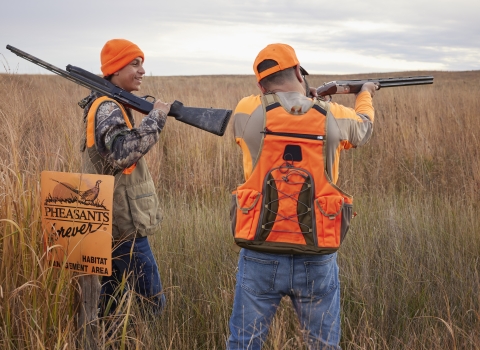“It is always funny when I am asked where I am from because it is such an easy question for most, but for a military brat, it always gives me pause. I usually answer that I am from a little bit of everywhere,” shared Alison Deary, the new center director at Abernathy Fish Technology Center in Longview, Washington.
Deary’s father was an officer in the U.S. Air Force, and her family packed up their lives every three years and moved to wherever the Air Force needed him to be. Although it was not easy moving, making new friends, and changing schools frequently, Deary viewed the ability to be immersed in new cultures, try new foods, and explore new parts of the country and the world as a major benefit. She often wondered if her childhood of adapting to new environments is what interested her in studying evolution and adaptation in fishes.
“For as long as I can remember, I have always been interested in nature, said Deary. “When the weather was nice, I was outside from sunup to sundown exploring the flora and fauna of the neighborhood. When the weather was not nice, I would watch nature documentaries, read National Geographic, and write book reports from old encyclopedias. If I was lucky, a parent would take me to a park, a museum, or the beach.”
There was never a question in anyone’s mind that Deary was destined for a career in the natural sciences. She attended the College of Charleston in Charleston, South Carolina where she graduated summa cum laude with a Bachelor of Science in marine biology and double minors in geology and chemistry. She recounts two formative experiences in college that propelled her to narrow her passion down to fishes: an internship working with mentors at the National Oceanic and Atmospheric Administration (NOAA) labs and an experience at sea focused on carbon cycles with the Sea Education Association.
Deary was awarded the NOAA Hollings Scholarship, launching her into a two-year program that paired her with Dr. Jay Orr at the Alaska Fisheries Science Center, identifying sponges collected in Alaska and archived at the California Academy of Sciences in San Francisco.
She spent long days working alongside NOAA scientists on a chartered fishing boat in the Bering Sea. The work was tough, processing and identifying tons of fish each day, but Deary found it truly inspiring seeing everyone work together to collect the data and make her, as a complete newbie, feel so welcomed and a part of the team.
Once back on land, Deary left to continue her internship in San Francisco where upon her arrival, her then new roommates wrinkled their noses at her, because according to them, she smelled of the sweet aroma of dead fish and diesel.
Deary shared her early inspiration to conduct research in the federal realm.
“As I think back on this internship, it was working with the NOAA scientists that solidified my love of fishes because of the diversity of shapes, sizes, and species I saw after each net collection on the boat,” said Deary. “And it affirmed my desire to be a federal scientist because I would be involved in the work from collection through communication with a supportive team of colleagues.”
Leading up to her internship with NOAA, she was also selected to participate in a session focused on carbon cycles with the Sea Education Association. Deary started the program in Woods Hole, Massachusetts, diving into carbon cycles and their influence on climate, and then spent six weeks on the SSV Robert C. Seamanssailing from Hawaii to Tahiti collecting water and organisms twice a day.
This was her first adventure on a boat in the ocean for longer than a night; she saw amazing fishes, places, and stars, and learned she should never be trusted to navigate a vessel by celestial bodies (thank goodness for GPS).
On this voyage, Deary also learned a new tradition — sailing across the equator, she and many of her classmates shaved their heads as an offering to Neptune for continued safe passage on the journey.
“Although my family was less than thrilled by my decision, it was empowering to cut off all of my hair and start fresh,” she recalled.
Deary’s favorite task aboard was being on bow watch at the front of the ship at night when they’d sail through a bioluminescent patch and the fluorescent green would glow for what seemed like miles all around. From this experience, she realized that she enjoyed conducting research at sea, was not very prone to seasickness (whew), and was most interested in the fishes they caught over any other organism.
When Deary returned to the College of Charleston for her senior year, she worked closely with her mentor to use temperature, oxygen, and acoustic data collected during Sea Education Association sailing trips to assess the potential habitat of four tuna species in the central Pacific Ocean and how it was impacted by oxygen minimum zones; this resulted in her first peer-reviewed publication.
Following her undergraduate work, Deary continued her academic journey. As long as she could remember, she always knew she would get a doctorate and attended the Virginia Institute of Marine Science, College of William and Mary for a doctorate in marine science. There, Deary refined her passion for fishes to the early life history stages — eggs, larvae, and juveniles.
“Fishes in many ways develop similar to butterflies,” she described. “Newly hatched fish larvae often do not look like the adults (similarly a caterpillar does not resemble the adult butterfly) because larvae have features to help them survive life in the ocean at such small sizes, in many cases smaller than an inch long; but as they grow larger, they lose these features and begin resembling adults.”
This general pattern fascinated Deary and drove her to ask: how early during development could individuals of closely related species select different prey, and what about their senses or jaws allowed for this selection?
Over the course of her nearly six years in graduate school, Deary visited seven countries and dissected 450 larval fishes to complete her doctorate, learning a vast suite of skills and techniques. As a full-time graduate student, it was not uncommon to find Deary most nights and weekends behind the scenes of the aquarium or behind a microscope with her trusty corgi Sookie supervising her work.
After graduate school, Deary and Sookie moved to Ocean Springs, Mississippi, where she was a postdoctoral researcher for a Gulf of Mexico Research Initiative oil spill consortium led by the University of Southern Mississippi. Their main interest was to be able to answer where the oil would have gone if the Deepwater Horizon oil spill had occurred in a different season and what organisms would it have impacted.
She worked closely with students, other postdocs, and principal investigators to organize research cruises in the northern Gulf of Mexico research vessels to accommodate the variety of projects their consortium was supporting. It was here that she was able to get back out on the big boats and became interested in scientific leadership.
Deary returned to Seattle where she secured a position with NOAA as the ichthyoplankton team lead, just upstairs from her former internship mentor. In this role, Deary was active in scientific leadership within her team, ensuring they were meeting mission and data excellence standards, developing diagnostic tools for fish identification both for in-house and broader scientific use, and communicating patterns to fisheries managers.
Each year in this position, Deary would spend three to six weeks at sea; her favorite area to sample was the western Gulf of Alaska because of the amazing scenery.
“You cannot beat retrieving a net sample with a rainbow overhead and a volcano in the distance!” she exclaimed. “Some of the datasets in this program extend more than 40 years, affording us the opportunity to ask questions about the impact of climate on the marine planktonic community, fish spawn timing, and prey availability.”
Professionally, working through the COVID-19 pandemic highlighted the aspects of Deary’s position at NOAA that invigorated her. She discovered she really enjoyed developing solutions to overcome obstacles to meeting milestones, streamlining operations, and collaborating across programs. This realization led her look for supervisory positions where she could maintain a pulse on research but also dive into leadership.
In her current role at Abernathy Fish Technology Center, Deary is excited to build relationships within the Service and especially with the team at Abernathy. As a lifelong learner, she is exhilarated to learn about a whole new field, ecosystem, people, culture, and emergent issues to accomplish fish and aquatic conservation goals in the Pacific Northwest and across the Service. She looks forward to sharing her perspective from the marine realm and experiences in federal service with NOAA to her current position.
The Abernathy Fish Technology Center is one of seven fish technology centers located across the country within the Service. Each center conducts applied research in various disciplines to address questions the Service can use to achieve the mission of conservation using the best available scientific research. Because of this, each center is unique with no two having the same combination of expertise.
To Deary, this is exciting, and ultimately, what attracted her to the position.
“At Abernathy, we have research occurring under three different programs: nutrition and physiology, genetics, and quantitative ecology,” said Deary. As the center director, my daily work is tightly coupled with the decisions and discussions that provide the team at Abernathy with the resources they need to continue their excellent research, which prepares the Service for the future when considering climate change climate change
Climate change includes both global warming driven by human-induced emissions of greenhouse gases and the resulting large-scale shifts in weather patterns. Though there have been previous periods of climatic change, since the mid-20th century humans have had an unprecedented impact on Earth's climate system and caused change on a global scale.
Learn more about climate change scenarios while connecting individuals and research to internal and external partners.”
On a personal front, when the sun comes out of hiding, Deary looks forward to exploring the local waterways of Washington. Her senior corgi, Sookie, is mostly wheelchair-bound (yes, they make wheelchairs for animals!) but she has found that Sookie really enjoys riding on the paddleboard.
More about the Abernathy Fish Technology Center:














